The Museum Collections
Introduction
I. History and Art Collection
1. Icons of the 14th – 19th centuries
icons of the 14th – 17th century
2. Jewelry art of the 14th – 20th century
jewelry art of the 14th – 17th century
jewelry art of the 18th – 19th century
the european silver 14th - 19th centuries
3. Small-size sculptures (works of metal, wood, bone)
XI – the beginning of the XX century
Small-size sculptures 11th – 17th century
Small-size sculptures 18th – early 20th century
enamel of Troitza masters 15-8th – early 20th century
5.Embroidery, lace, textiles of the 14th - early 20th century
icon and ornamental embroidery
gold and silver lace
6.Painting of the 18th – 21st centuries
painting of the 18th – 19th centuris
painting of the 20th – 21st centuris
II.Manuscripts and old printed books of the 14th – 17th century
IV.Lithography of the 18th – 19th century
V.Numismatics
VI.Medals of the 18th - early 20th century
VIII.Archeology collection
IX. Russian folk and applied and decorative art of the 17th – 21st c.
1. Artistic wood
folk carved and painted wood
wooden toys
house carving of Sergiev Posad
Khokhloma and Gorodets painting
2. Artistic textiles
embroidery and weaving
printed textiles and lace
Russian shawls
folk costumes
folk garments
printed cotton kerchiefs
|
The 18th – early 20th Century Trinity Enamel
|
Enamel means an “alloy” or “shining stone”. So they call painted enamel. In the first half of the 18th century, the Trinity-St. Sergius Monastery reached the peak of its prosperity. Enamel, encouraged by Peter the Great, was mastered by the Trinity craftsmen. Of numerous works of the 18th century Trinity masters there mainly survived enamel plaques that decorated precious works preserved in the Sacristy of the Sergiev Posad Museum-Preserve.
Hieromonk Pavel Kazanovich played an important role in the formation of the unique art school in the Trinity-St. Sergius Monastery. He did not sign his works, but his hand can be traced in the composition “The Trinity of Old Testament”. Under his supervision the Trinity craftsmen went to St. Petersburg to study European painting and copied works of foreign artists. The cover for Gospel of 1757, decorated with enamel plaques, is a specimen of the Trinity enamel.
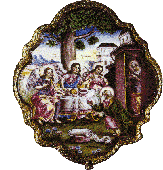
The Trinity of Old Testament. 1751. Plaque from the Gospel cover. 1754. (Obverse) |
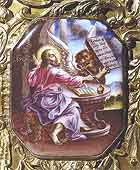
St. Mark the Evangelist. Plaque from the Gospel cover. 1754. (Obverse) |
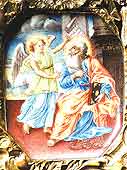
St. John the Evangelist. The plaque from the Gospel cover. 1754. (Obverse) |
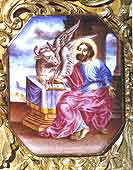
St. Luke the Evangelist. The plaque from the Gospel cover. 1754. (Obverse)
|
The mid-18th century enamel painting decorated precious articles produced in the Monastery. Metropolitan Platon (Levshin) in every way supported the work of enamellers. By his order the Monastery art team was formed.
|
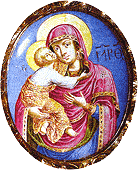
The Virgin of Vladimir. The plaque from the Gospel cover. 1754. (Reverse). |
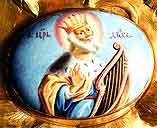
King David. The plaque from the Gospel cover. 1754. (Reverse). |
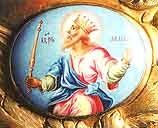
King Manasseh. The plaque from the Gospel cover. 1754. (Reverse). |
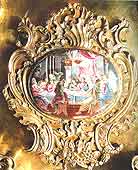
The Sacred Super. The plaque from the Gospel cover. 1754. (Reverse).
|
|
Since the late 18th century the Trinity enamel gradually faded away as to sell purchased goods proved to be more profitable than to produce. The Trinity Monastery began to buy a lot of enamel items from Rostov the Great. Still enamellers went on working. Among the specimens of the 19th century enamel there are icons different from Rostov works. They look like the Lavra lithographs. The enamel icon “St. Seraphim of Sorov” of the early 20th century is an interesting example in this respect.
|
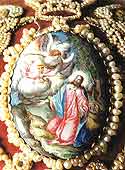
Praying for the Bowl. 1750s. The plaque from the mitre |
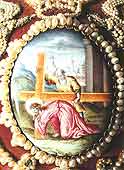
Carring the Cross. 1750s. The plaque from the mitre |
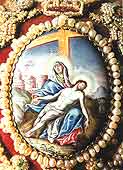
Lametation. 1750s. The plaque from the mitre |
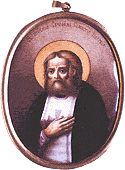
St. Seraphim of Sorov. Early 20th century
|
|
|


